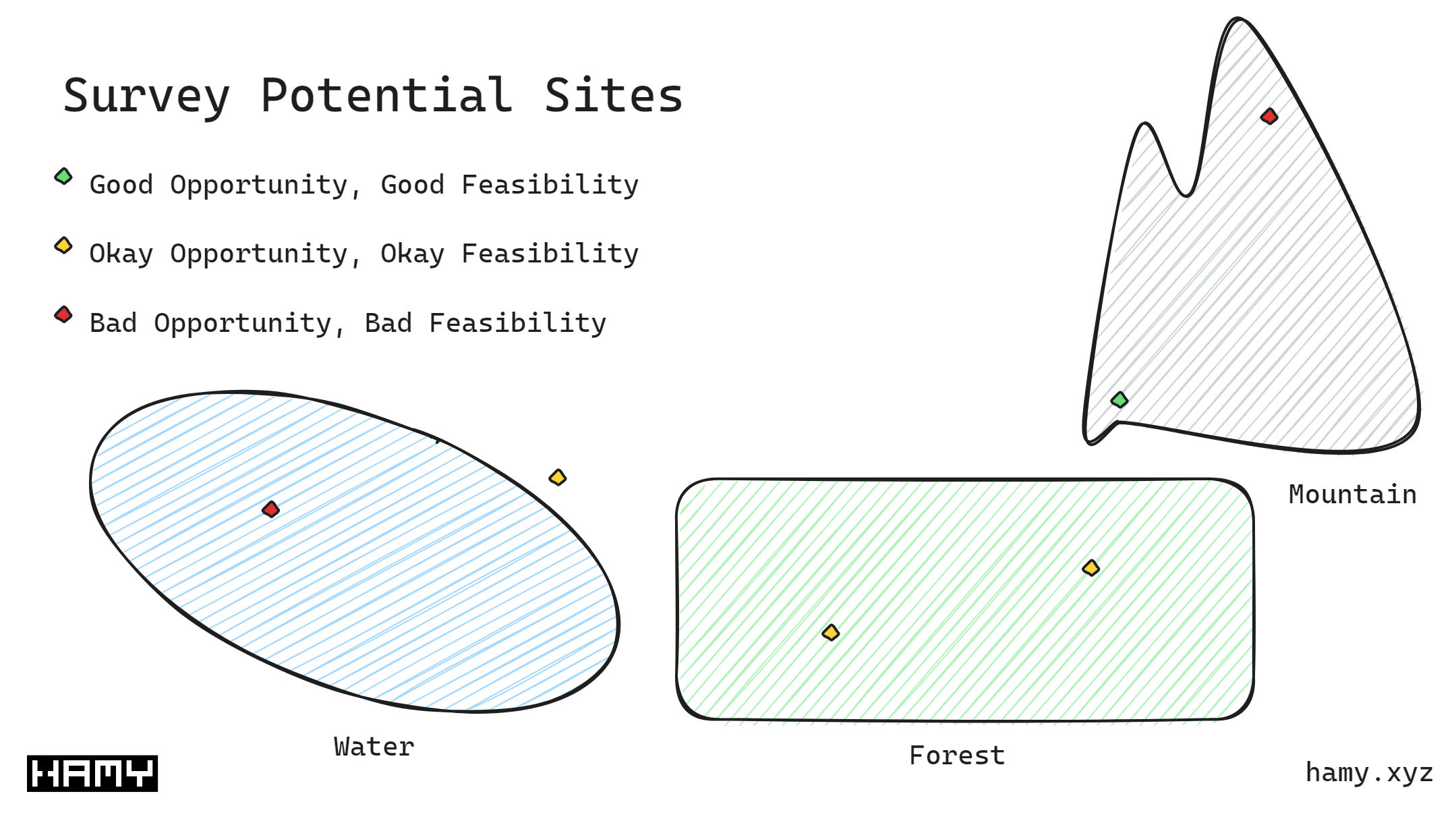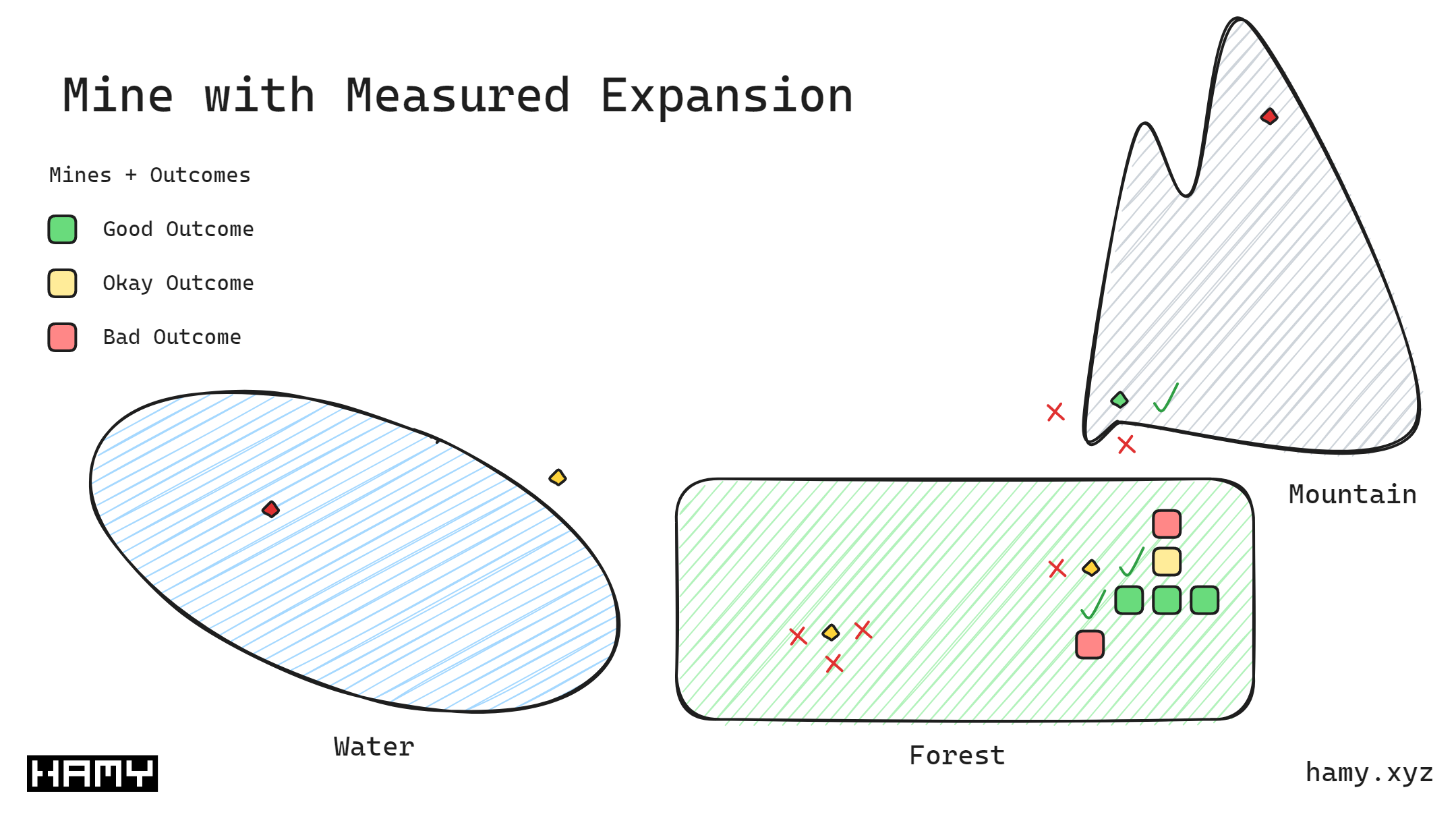Stop wasting your time on Bad Startup Ideas
Date: 2023-11-15 | business | create | startups |
Most startups fail (usually calculated at ~90%). A common cause is founders / builders spending lots of time and money building something only to release it and find out it's not valuable:
- No one wants it
- No one wants to pay for it
We've previously discussed several ways to mitigate this build trap and how Focusing on Impact can prevent wasted resources across many dimensions.
In this post we're going to be exploring a useful mental model for startups and how we can leverage it to avoid sinking resources into bad startup ideas in the first place.
This post is inspired by the mining metaphors from this post: Don't Build a Mine Before You Struck Gold
Startups as Gold Miners
The core metaphor is to think of startups like a gold mining expedition:
- Expedition - The people in the startup trying to profit
- Gold - The Market you will try to leverage
- Mine / Mining - The business you will build to leverage the Market
Thinking about it this way, there are two core phases required for the Expedition to successfully extract the Gold:
- Looking for Gold - You must find a place with Gold before you can extract it
- Mining for Gold - Once you find the Gold, you have to get it out
Don't dig where there isn't Gold
Thinking about it this way, it's pretty obvious that if we dig in a spot where there isn't Gold, we won't get any. Worse yet, Mining is quite expensive if we want to do it efficiently. But if we Mine efficiently where there isn't Gold, all we're doing is wasting our resources more efficiently.
Mining is expensive because:
- Build the Mine (lots of startup / ongoing costs)
- Pay workers
- Provide supplies (food, shovels)
- Hard to move - Once we've invested in a specific spot, we can't take all the holes etc we've made to the next one! This makes many of these costs non-transferrable.
Yet this is commonly what startups do. They find a spot and build a Mine. But there may not be any Gold there so it's destined to fail!
How do we avoid this? In the same way that we would avoid building a Mine where there isn't Gold.
To find a good Mining spot, try to fail fast / cheap by invalidating sites that don't seem promising with the cheapest checks. If it passes, we move on to more expensive / more rigorous tests.

Survey potential sites - based on land features / what you know, you may be able to pick some sites with higher probabilities of containing Gold

Sample those sites for Gold - We still need to check if they have Gold. Sample the ground with a few small, deep holes and estimate what the opportunity is for the site.

Mine with measured expansion, validating against estimates - Even if a site is promising, it may still be a dud. We balance our need to avoid ruin and want to maximize upside through measured expansion of our mine - validating results against estimates and course correcting as we go.
Even if we do this right, we're bound to come across a lot of duds and even start small mines at several duds. But that's reality - there's a lot we just don't know and thus we have to test it to find out what's there. This process is not easy / cheap but it does limit the amount of resources we invest in these duds, allowing us to get to non duds faster and with more resources available.
How to avoid bad startup ideas
So how can we apply this to the land of startups?
- To avoid bad Mines: Don't dig where there isn't Gold
- To avoid bad startups: Don't build where there isn't opportunity
In the same way that most Mining sites won't contain Gold, most Startup Ideas won't be very good. But it's also true that we can't really know if a given Site / idea is good / bad until we test it. We can (and should) utilize data to estimate the potential of a Site / Market / idea to remove those that are very likely bad but we can't really tell which are very likely good.
So we need to test these Sites / Ideas to see how good they are. The faster / cheaper we can do this, the more likely it is we'll find a good one and still have the resources available to Mine it.
Timing the market is v hard.
— Hamilton Greene (@SIRHAMY) October 29, 2023
Your best bet is to make small bets over time to increase your surface area for luck while avoiding ruin.
Good small bets:
* The world needs (and will pay for) it
* You enjoy the work / are interested in the area
* You are good at it https://t.co/D164LIqcEW
- Survey potential Ideas - The first step is finding ideas and trying to bubble up the most promising ones. Most of these ideas will be bad but usually you need to go through a bunch of bad ideas for a few good ones to pop out and bubble up (see: How I run my Project Backlogs). Once you have a backlog of ideas, use some heuristics to try and narrow it down to several you think are useful to sample. My go-to heuristics are: 1) Does the world need it (and will it pay for it)? 2) Am I interested in this Problem area / the work required? 3) Am I good at this / well-positioned to solve it?
- Sample those sites for Opportunity - Now that we have some ideas we're interested in pursuing, we now want to test whether they have any Opportunity before investing in a full-fledged Mine. Use small, cheap experiments like talking to more potential customers about their problems (a la The Mom Test) and building MVEs (Minimum Viable Experiments) to test Problem<>Solution<>Market fit.
- Build with measured expansion, validating against estimates - If your Idea proves to have Opportunity, it may be worth starting to Mine (Build for). But we still must realize that just because our early experiments say there's opportunity, the overall Idea may still prove to be a dud. So don't invest months and your entire warchest bringing in the heavy machinery. Instead, continue to expand with MVEs (Minimum Viable Experiments) for changes, improvements, and new features, always validating the results against your expectations to maximize for the opportunity while guarding against investing in a dud.
This process of measured expansion is what I call the Creation Cycle (Observe, Create, Reflect loop) and has been explained in many forms (like the Build-Measure-Learn loop from The Lean Startup).
Next
In the end, building a Startup (like Mining) is a game of odds. Our best bet is to make many small bets to validate opportunities before investing. Once we decide to invest, we should still iterate sustainably with conscious Creation Cycles to maximize returns while minimizing risk of ruin.
If you liked this post, you might be interested in:
Want more like this?
The best way to support my work is to like / comment / share for the algorithm and subscribe for future updates.
